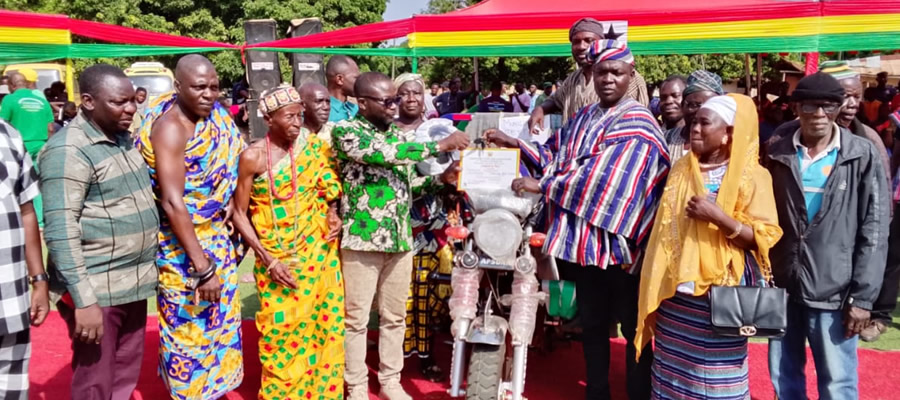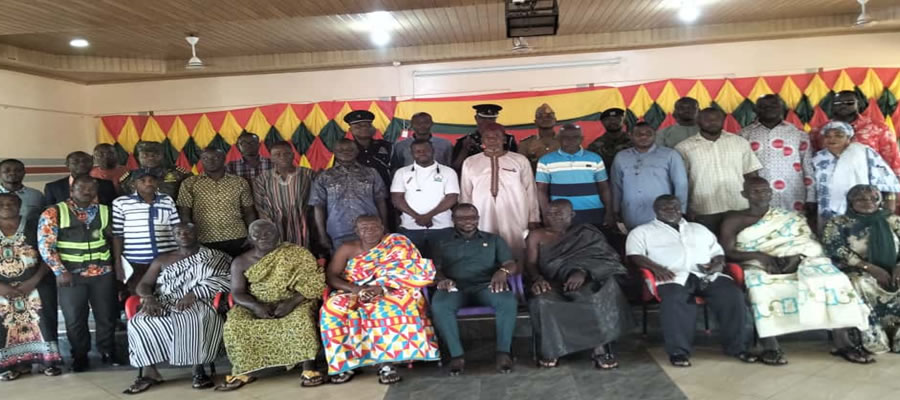

DISTRICT DEVELOPMENT GOAL AND OBJECTIVES
Introduction
Goals are defined as broad statements of intent expressing desires, which are geared towards an improvement in the general wellbeing of the people. Since local communities are the beneficiaries (or losers) of any development effort in the district, it is of paramount important to consider their goals and/or aspirations, which were generated from the grassroots/community level in the design of programs and projects.
The Kintampo North Municipality Development Goal was formulated to guide development in all sectors of the district’s development as outlined in the five (5) pillars in accordance with the National Development Planning Commission (NDPC) Guidelines. This chapter concentrates on the Kintampo North Municipality Development Goal, Objectives, Development projections and strategies to achieve the goal.
District Development focus and Goal
Using lessons learnt from the review of the previous MTDP as well as the outcome of the situational analysis, the Kintampo North Municipality shall focus on adopting suitable measures that will build upon the gains already achieved from the previous MTDP 2014-2017 by making the best use of the strengths and opportunities available to the Municipality while at the same time putting in place measures to either eliminate or minimize the effects of identified challenges and threats that hinder in the desire to advance the Development process of the Municipality.
Thus the Kintampo North Municipality shall focus on sustaining growth and development, poverty reduction and equity through good governance and provision of basic socio-economic facilities. This is a sure way of further improving standards of living of the people in the Municipality.
The key development issues are issues of concern which impede the development initiative of the Municipality. The underlying principle for identifying and dealing with the key development issues is that of removing the factors, which inhibit development so that development efforts would yield results more easily. In this wise the Municipality would not have to “push development” but rather deal with the inhibitors to development.
As part of the broad goal of the Municipality is to improve upon the living standards of people in kintampo through the provision of basic amenities and services, the development of the private sector and the creation of a congenial atmospheric environment for all inhabitants to actively contribute to the positive socio economic and spatial transformation of the Municipality.
District Development Projections (2018-2021)
Population has been identified as both determinant and consequence of development and as a result must be considered central to any development planning activity. In view of this, the district population has been projected to assess the basic demographic characteristics over the next four (4) years (2018-2021). The population projection has also been computed to estimate the social, technical, and economic needs over the plan period.
Population Projection
Population projection is vital within the development planning process. This is because the size and composition of human population changes overtime with corresponding changes in the numbers and levels of social infrastructure requirements. Based on the Municipality Development Goals which highlight on the desired state of the Kintampo North Municipality by 2021 and the specific objectives, developmental projections have been undertaken to provide inputs into strategies and activities to be undertaken in order to realize the dreams and aspirations of the people of the Municipality.
Using a growth rate of 2.6% and an estimated population of 117,243 for 2018 as the base year, the population has been projected based on the following Assumptions.
To determine the required services by 2017, threshold levels of the various services were collectively identified. The table below contains the threshold of the various services/facilities.
MONITORING AND EVALUATION ARRANGEMENTS
Introduction
Monitoring is the systematic process of collecting, analyzing and using information to track a programmes progress toward reaching its objectives and guide management decisions. It involves the process of measuring, recording, collecting, processing and communicating information about the performance of stage of the project. It is extremely important to institute measures to keep track of the Implementation and Management of Town and Zonal Council initiatives. This ensures that activities are implemented on time and with the required level of efficiency.
Monitoring and evaluation activities at the district level are the responsibilities of the Municipal Monitoring and Evaluation Team/ MPCU in conjunction with other agencies and project beneficiaries. Project monitoring formally begins as soon as actual implementation starts and it is directed at tracking progress and providing feedback for informed decision-making in the implementation of Programme interventions. Monitoring is carried out to ensure that activities are progressing according to schedule, standard, and correct delivery of input according to time, quality and quantity.
At the Municipal level, objectives for monitoring include:
- To ascertain whether or not activities are on track and take corrective measures where possible.
- Identify successful interventions for replication in other areas of the Municipality.
- Obtain periodic data for further planning.
- Promote co-ordination and balance in service provision and utilization.
- Motivate as well as strengthen the capacity of the various actors such as government departments/agencies, NGOs, CBOs, FBOs and the private sector in the collection and utilization of relevant data to improve on service delivery.
Based on the problem/needs assessment, Indicators for monitoring the Kintampo North Municipality projects will be based on the objectives of the project and the work plan/Programme of action. It is anticipated that development projects and activities will be participatory monitored by financiers, the Kintampo North Municipal Assembly, the Town and Zonal Councils.
Monitoring and Evaluation Arrangements
Monitoring of Physical Project
The Municipality already has its monitoring tem in place led by the Municipal Development Planning Officer. This is in line with the NDPC guidelines. This team is to assist the Municipality to monitor implementation of programmes and activities of the plan. Since monitoring aims at assessing progress of work and filling the gaps rather than faultfinding mission, it is essential that the exercise be undertaken with the active participation of the various actors.
Reporting on Monitoring Activities
On quarterly basis, the Kintampo North Municipal Assembly, Monitoring Team will put together a report on progress of implementation of activities for circulation to the Municipal Chief Executive and other stakeholders. Copies are to be sent to:
1 Regional Coordinating Council/ RM&E Unit
2 Ministry of local government and rural development
3 National development planning commission and
4 Project Financiers.
Mid – Year Review
Apart from the periodic monitoring activity, there shall also be a mid-year review of the annual work plan to ascertain:
• The progress made in implementing the year’s work plan and budget.
• Status of implementation of programmes, projects and activities.
• The extent of achievement of indicators in the plan and budget.
• Outstanding activities and their continued relevance to area and district development
• Identify programmes, projects that can be rolled over to the ensuing year.
Evaluation of Development Programmes
Evaluation is the process of determining systematically and objectively, the relevance effectiveness and impact of activities in the light of set objectives.
Unlike monitoring, evaluation is conducted in greater detail at the project level. Evaluation is to be carried out within specific intervals: at mid-point (18 months of implementation) and end points (three years of implementation – 2021).
Data should be generated through routine evaluation systems of departments. The focus should be set for objectives and expected outcomes. Subject to availability of funds, the Municipality can organize a report of the baseline survey to determine extent of change.
The findings of such evaluation should be discussed at stakeholder workshops. The outcome of the exercise will feed into the preparation of the next Municipal Development Plan.To encourage/promote participatory evaluation, beneficiaries of various developmental projects in Kintampo North Municipality will take active part in the project evaluation. Strengths and weaknesses of beneficiaries shall be examined so that they can contribute meaningful to the success of the work.
Identification and Analysis of Stakeholders
For participatory M&E, different groups of stakeholders are identified. This is believed to lead to sustained capacity building, dissemination and demand for M&E results. Some stakeholders identified in the district and their responsibilities are contained in table below:
Monitoring Indicators
One of the critical issues in M&E plan is defining the most appropriate indicators and setting achievable targets that are related to the MMTDP Goal and objectives. Indicators are needed for measuring progress whilst targets are the sign post that will lead to the stated goal and objectives. The NDPC in collaboration with relevant stakeholders are yet to define some core national indicators and targets to be monitored in all districts. Table 6.3 contains the Municipal indicators and targets set that are directly related to the MMTDP.
Monitoring and Evaluation Calendar
This part of the M&E plan focus on the time frame for each of the activities as well as indicative budget and the various actors to the monitoring and evaluation process. Table 6.3 contains the M&E Calendar of the MMTDP.
Date Created : 12/20/2017 5:23:54 AM












 facebook
facebook
 twitter
twitter
 Youtube
Youtube
 +233 593 831 280
+233 593 831 280 0800 430 430
0800 430 430 GPS: GE-231-4383
GPS: GE-231-4383 info@ghanadistricts.com
info@ghanadistricts.com Box GP1044, Accra, Ghana
Box GP1044, Accra, Ghana